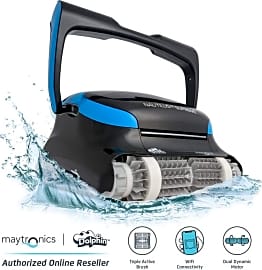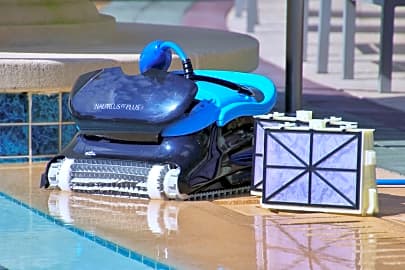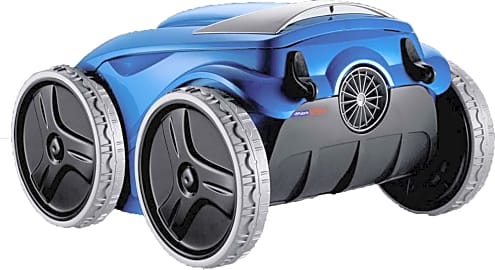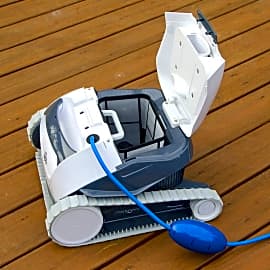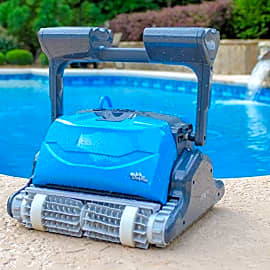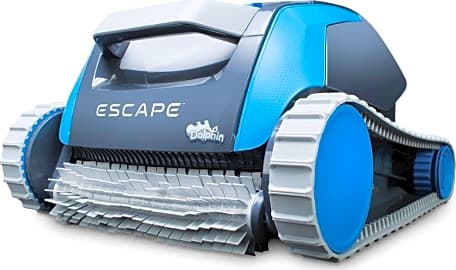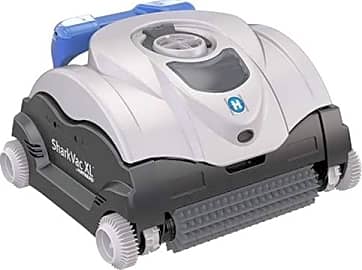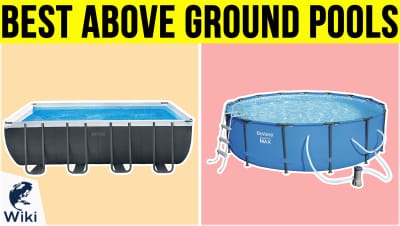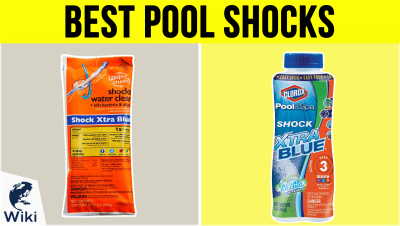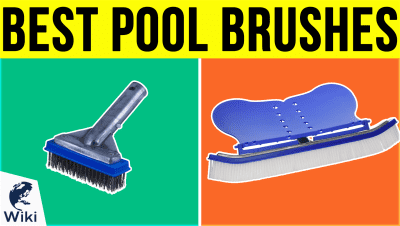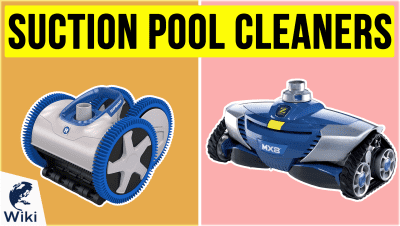The 8 Best Robotic Pool Cleaners

This wiki has been updated 43 times since it was first published in April of 2015. There's nothing better than having your own personal oasis to cool off in on a hot summer day. In order to keep that water crystal clear and minimize physical effort, you'll need one of these robotic cleaners to stay ahead of the mess. We've included models for above- and in-ground pools that offer programmable schedules, powerful vacuums, and sturdy brushes that scrub floors, steps, and walls. When users buy our independently chosen editorial selections, we may earn commissions to help fund the Wiki.
Editor's Notes
August 06, 2021:
The handful of tried-and-true automated pool cleaners that we recommended last time are all still great choices. There was one big change worth making, and that was the addition of the Dolphin Sigma in the top spot. It isn't meant to remove the bulkiest debris, but it does such a consistently good job that it's worth skimming the leaves from the pool first. If you want to save some money, the Dolphin E10 is a great choice, while the Zodiac Polaris Sport F9550 remains one of the top ultra-premium options.
May 29, 2020:
A cursory search will pull up a decent handful of robotic pool cleaners, and in fact a bit more than just the 7 we've listed here. The thing is, these tend to be pretty expensive devices, and in the interest of consumers, we've done our best to determine which are actually good investments in terms of reliable cleaning and durability. One brand has proven to be pretty consistent in the build quality of their products, which is why the Dolphin Nautilus CC Supreme and Dolphin Nautilus CC Plus took the top two spots. One is quite expensive, and the other more reasonably priced, and they both deliver great cleaning capabilities but with differing amounts of smart control. The Dolphin Oasis Z5I also offers smart mapping and Bluetooth connectivity, although its wireless functionality isn't all that helpful, and it tends to run into traction problems on uneven surfaces such as drains. The Dolphin E10 is considerably simpler and has a bit less navigation prowess, but it's pretty affordable for the category. The same can be said for the Dolphin Escape, although it's designed specifically for the smaller dimensions usually held by above-ground pools.
In terms of other brands, there are still some great options, such as the Zodiac Polaris Sport F9550. It's pretty costly but offers a great degree of suction, and its navigation is on a par with the best. The Hayward SharkVac XL also performs extremely well on floors and slopes, but it can't quite compete with high-end models on vertical walls, and those who are even slightly mobility challenged will have a hard time dealing with its significant heft.
One important point to remember when purchasing a pool robot is that not all filters are built equally. Before using one of these for the first time, make sure you've got the right attachments; a large debris filter will have a wider mesh, and for everyday use you'll almost certainly need a fine-mesh filter. It's also good to keep in mind that a cleaning robot is only part of the tool set you'll need to keep everything perfectly tidy. Proper chemical cleaning and manual tools are also important to maintaining a fun and healthy pool.
April 19, 2019:
Added an upgraded version of the Dolphin Oasis Z5I due to its powerful twin motors, tangle-resistant swivel cable, and built-in Bluetooth connectivity for programming the unit from any smartphone. I thought the Zodiac Polaris Sport was a worthy addition, thanks to its rear-based water propulsion system and patented vacuuming technology, which helps to ensure superior cleaning results on stairs and in tight corners. I'm sure those things are pain points for many pool owners trying to get the deep end as clean as possible. The self-navigation capabilities of the Nu Cobalt NC74 ensures coverage of large swimming pools, while the unit's padded rollers make it well-adept at scaling walls and removing dirt from any location. Another innovative option is the Dolphin Nautilus Plus, which can use its own scanning technology to map out the best route to efficient cleaning, while its pop-up filter cartridges are super-easy to remove and replace. Although it may be limited to above-ground use, the Aquabot Pool Rover is still a worthy option due to its extra-wide wheels, reusable filter bag, and low-maintenance pump motor. The tank-style tracks on the Dolphin Escape make it a good option for traversing floors with large drains, while the lightweight frame makes it easy to transport. I thought the Hayward SharkVac XL was a good upgrade from the previous model, as this one can automatically reverse its direction if it happens to come out of the water upon cleaning on the water line. Finally, I added the Aquabot X4 for its compatibility with all pool types and the capacity to move up to 85 gallons of water per minute.
Why Opt For A Robot Instead Of A Human?
If you're of the mindset that robots are taking over the world, you may not like the idea of a little robot cleaning your pool.
If you're of the mindset that robots are taking over the world, you may not like the idea of a little robot cleaning your pool. But while you may be too attached to your friendly pool cleaner to replace him with a machine, you're probably paying too much for the services of a human pool cleaner.
Professional pool cleaners charge you not just for the time they spend working on your pool, but also the time they spend driving to and from your home. You don't need to pay a robotic cleaner to drive to your home; it lives there permanently. Robotic pool cleaners can also reach areas that a person cannot. When was the last time you saw your pool cleaner standing in your pool, with goggles on, scrubbing grime off the walls? Likely never.
A robotic pool cleaner can cover every nook and cranny of your pool, scraping algae and grime buildup from the floors and walls. Robotic pool cleaners also have much better dirt-catching systems than the professional pool cleaner, who typically uses a large mesh bag attached to the end of a pole to clean your pool. A robotic pool cleaner can also use finer mesh filters to pick up minuscule debris that cannot be seen by the human eye.
Possibly the biggest benefit of having a robotic pool cleaner is that it works on your schedule. You don't need to share it with other clients, as you do with a professional cleaner. And if you want, you can clean your pool every single day with a robotic cleaner.
More Ways Robotic Pool Cleaners Save You Money
Let's discuss how these units operate. A robotic pool cleaner uses two motors: one runs a water pump that sucks dirt and debris into and through a filter, and a second drive motor propels the cleaner around the pool. The entire system is powered by a transformer that plugs into a standard wall outlet. These units run on a low-voltage circuit especially designed to be safe for water usage.
The upfront expense of a robotic pool cleaning system is no small investment, but it's possible to make that up in energy savings in the first year of ownership.
Robotic cleaners do not plug into your pool system, but use their own, separate receptacle to hold all the dirt and debris they collect. This means your pool's pump basket can work less, potentially prolonging the life of your pool's pump system and filter in the process. This helps maintain the proper water chemistry, reducing the opportunity for algae growth, which not only results in a better looking pool, but also reduces the human effort needed for pool upkeep.
While robotic pool cleaners seem expensive, their energy efficiency can lead to significant savings in the long run. Compared with the annual energy consumption for pool pump filtration, robotic cleaners save several hundreds per year in energy costs. For pools running a separate booster pump, those savings can increase by as much as 50%. The upfront expense of a robotic pool cleaning system is no small investment, but it's possible to make that up in energy savings in the first year of ownership.
How To Choose The Right Robot For You
There are hundreds of models available, but not every robotic pool cleaner will be right for you. One major consideration is the size of your pool, which should determine the filtering capacity of your cleaner. If the filter reaches full capacity before your pool is entirely clean, then your robot is just wasting energy, dawdling around the pool without picking up any more dirt.
You should also consider the type, layout and lining of your pool.
One very popular feature is smart navigation. Most of the newer robotic pool cleaners have smart navigation that learns about your pool and figures out the quickest, most efficient route to pick everything up in the least amount of time. Older models just send the robot aimlessly around your pool, doing several laps and wasting your money.
Another very helpful feature is a built-in timer. While old models would turn your robot on at the same time every day, whether your pool needed cleaning or not, current versions let you customize the days and times cleaning is desired. Built-in timers can ensure you're making the most of your robot, by putting it to work at peak dirt and debris times. There's no point in running your robot when your pool is clean, after all.
You should also consider the type, layout and lining of your pool. Is it above-ground or inground? Are the floors and walls smooth, or are the surfaces bumpy? Is your pool rectangular, with 90-degree angles in the walls, or is it more curvaceous? These characteristics should play a part in helping you choose the type of wheels or rollers your robotic cleaner uses. Some don't even move on standard wheels, but on a contact adhesive drive that can stick to just about any type of pool surface.


